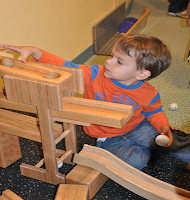In fact, it’s now known that even fairly young babies are aware of numbers. Some research has shown that babies can tell when the number of objects they’re looking at has been changed. Toddlers, too, are beginning to figure out mathematical ideas. They might be too young to say counting words, but they clearly understand that valuable math concept called the one-to-one principle. They realize that you can only put one shoe on each foot. And you might see them give a knowing grin when they wave a toy in each fist. Older toddlers often enjoy handing one cup to each person in pretend tea party. In the preschool years, you’ll probably hear your child using number words. But at this stage, as anyone who has ever played hide-and-seek with a young child knows, they often don’t have a clue as to the order to say them in.
Herbert Ginsburg in his book Children’s Arithmetic writes that one of the problems in learning to count is that “...people are very fussy about how you say these words. You have to say “four, five, six”; you cannot say “four, six, five.” Children become confused: what’s wrong with “four, six, five?” Aren’t they exactly the same words as “four, five, six?” Ginsburg compares it to learning a song with meaningless words. From a young child’s viewpoint, the whole thing is made more complicated by what happens as soon as they’ve figured out “four, five, six.” Along comes “seven, eight, nine.” Then “ten, eleven, twelve.”And on and on, all in a particular order.
Every young child starts out by counting in a mixed-up order. Rather than worrying about such typical mistakes, expect them, and continue to have fun counting aloud together. Your child will eventually pick up on the standard order just from counting along with you, over and over again. After a while, children begin to make the connection between the number words they’re saying and objects to be counted. Your child watches you count and realizes that often you touch things as you say the words. So she tries it, too. Sometimes she skips an object, though, and sometimes she touches it twice. All young children make these mistakes. Figuring out how to attach numbers to things takes lots of time. Years, in fact. Counting ten red triangles is a lot more complicated than finding two mittens for your two hands. But maybe that’s why children find it so interesting.
The best thing you can do is support that interest. Remember that children will keep on trying when they’re not worried about making mistakes. Give your child lots of informal and playful opportunities to count along with you. Count the stairs at the Museum as you go up or down. Count blocks while you build or balls as you roll them down ramps. Count the buttons on his sweater as you fasten them.
Who counts? Your children do--no matter what their ages are. So wherever your child is in the process of learning to count, enjoy it together.
Guest Blogger: Sally Nurss, M.Ed. has worked directly with children, parents, and teachers for over 25 years. She is a former preschool director and also a DCM Early Childhood Specialist. Sally and her husband, Jim, now own a bookstore, Our Town Books, in Jacksonville, Illinois.













